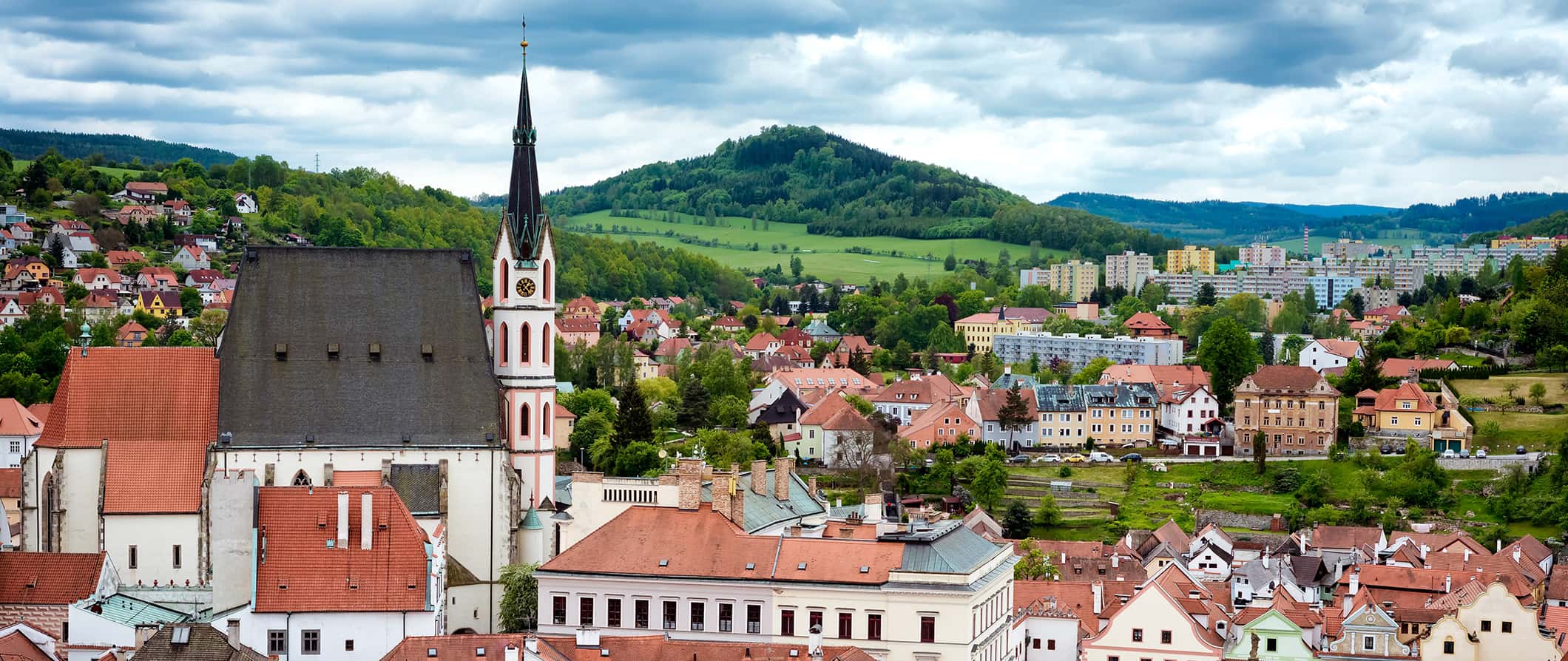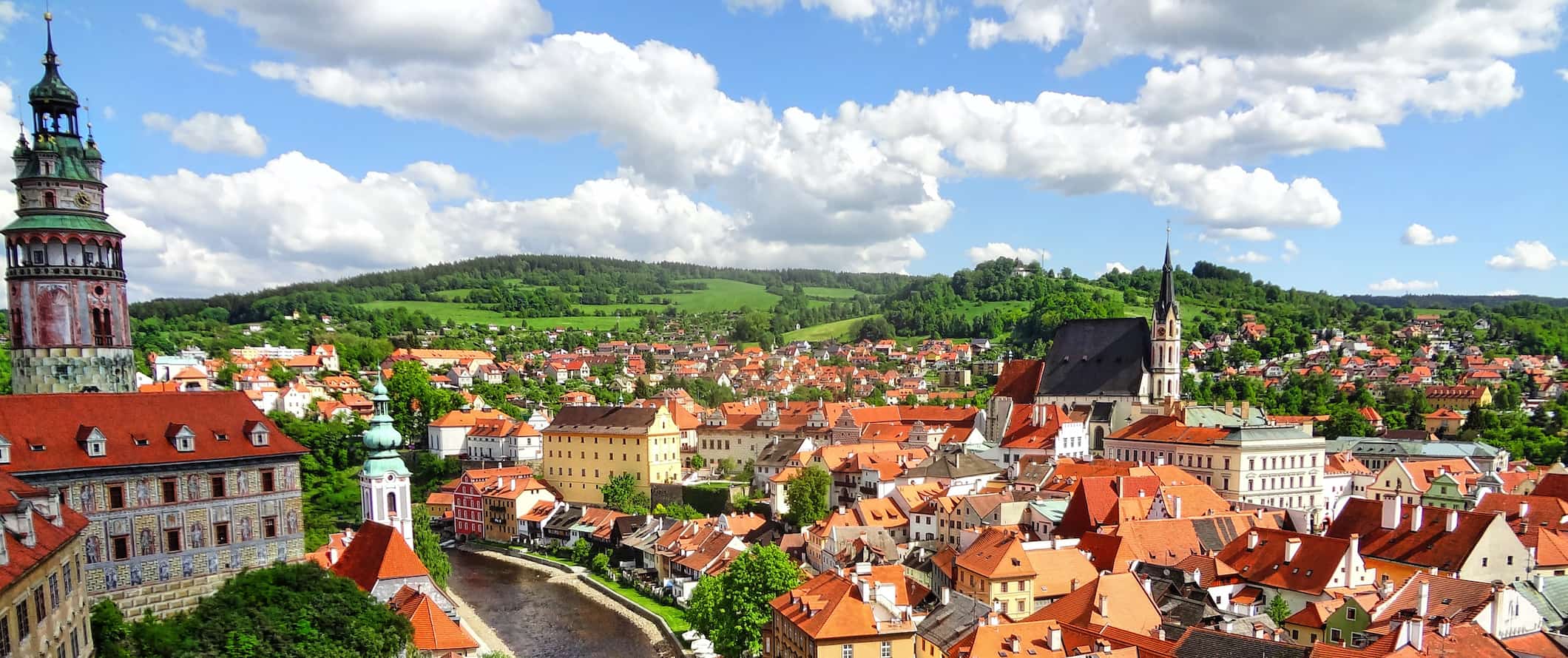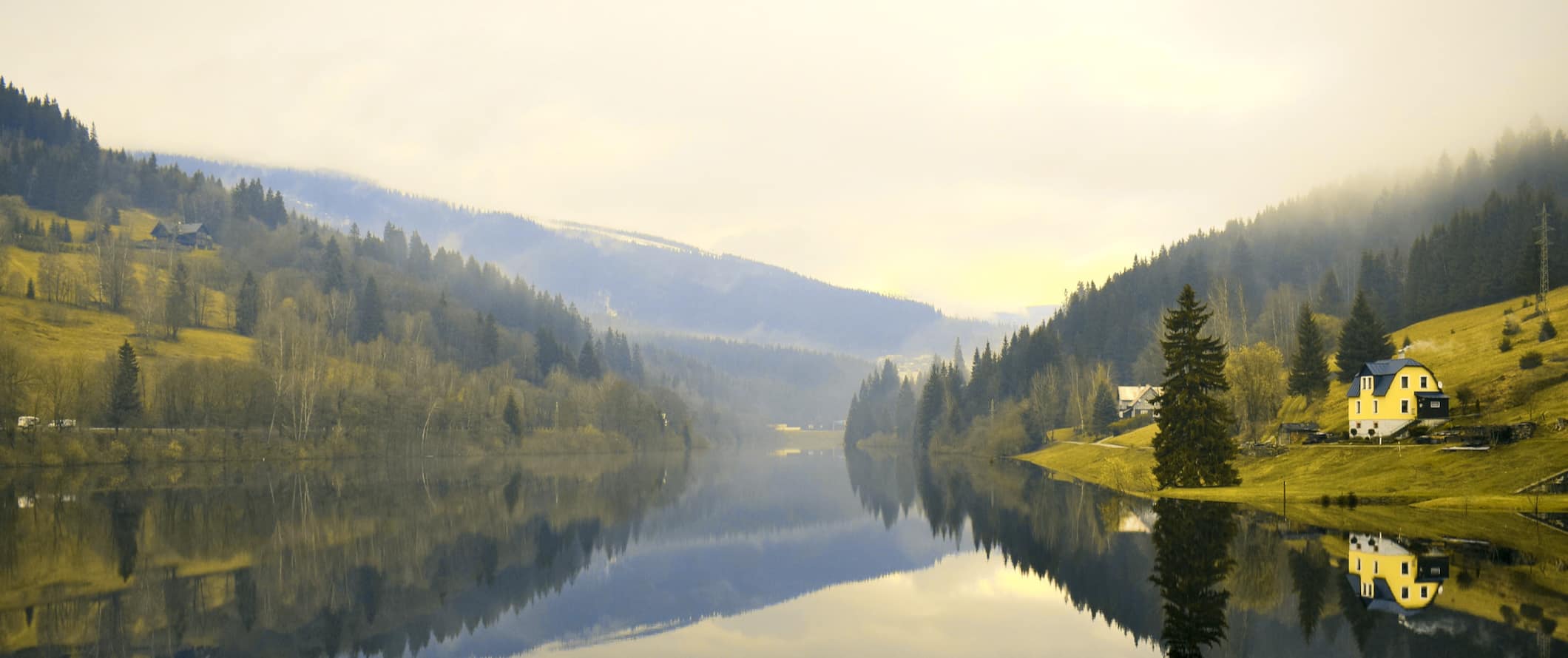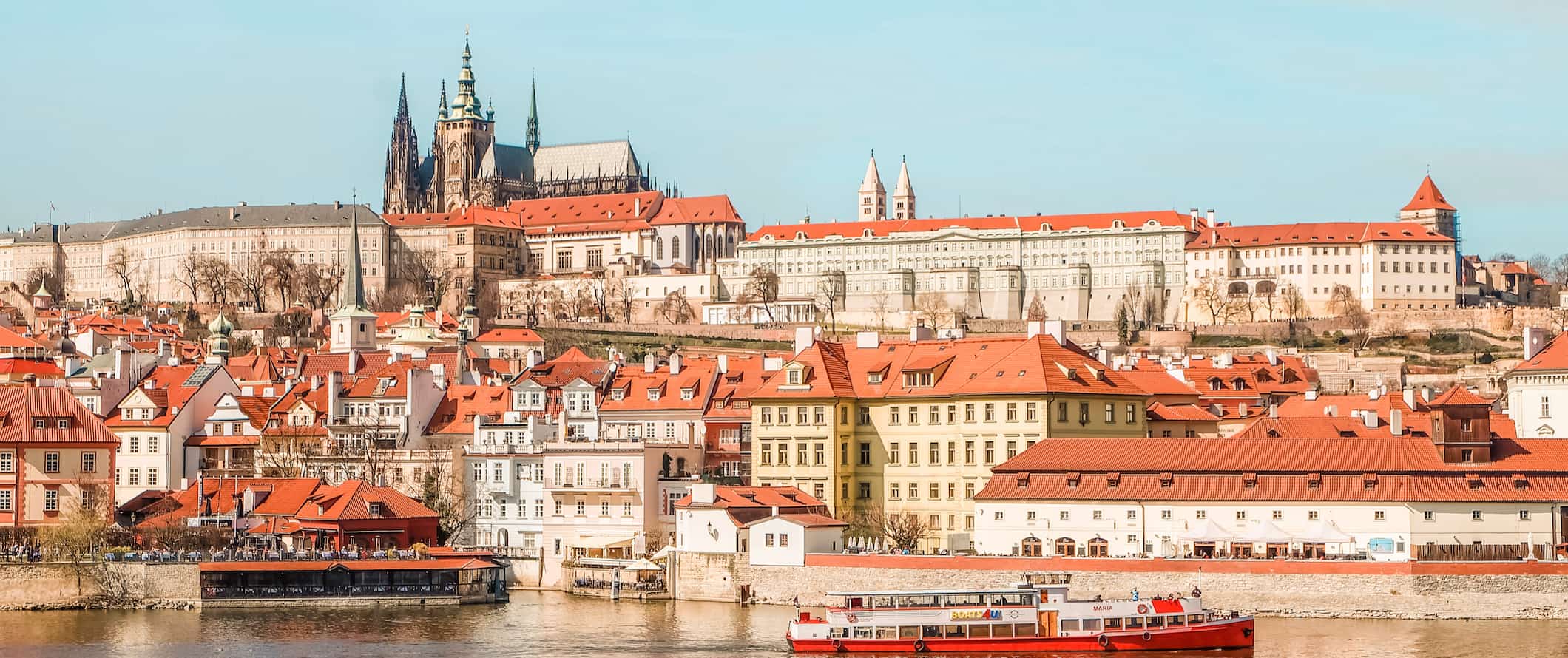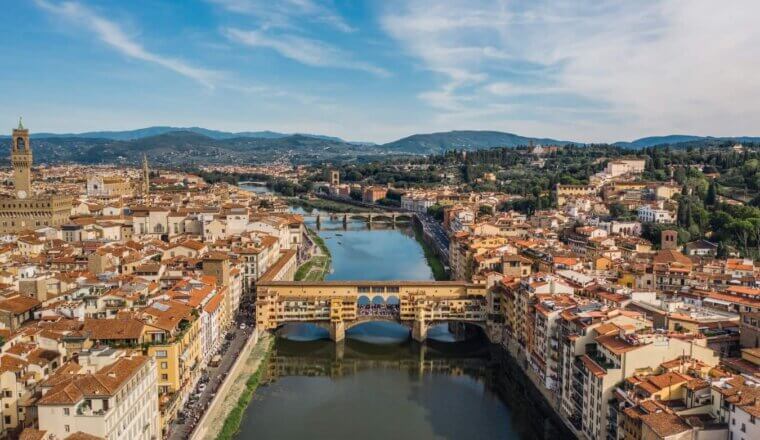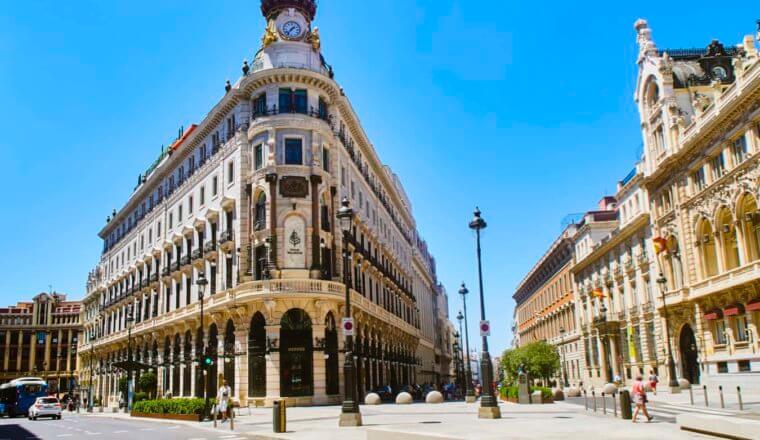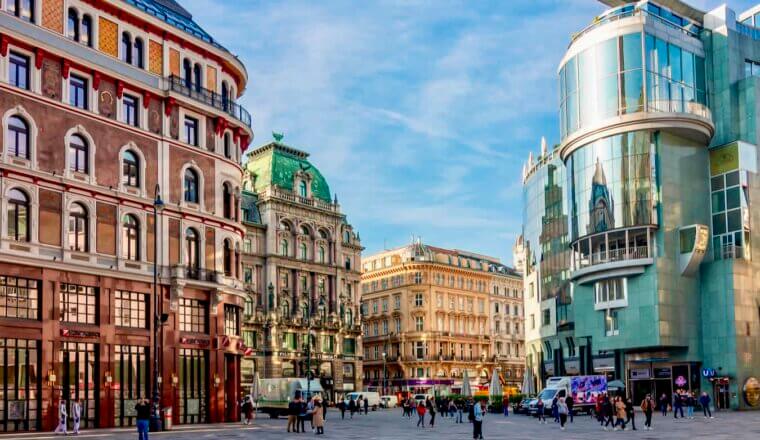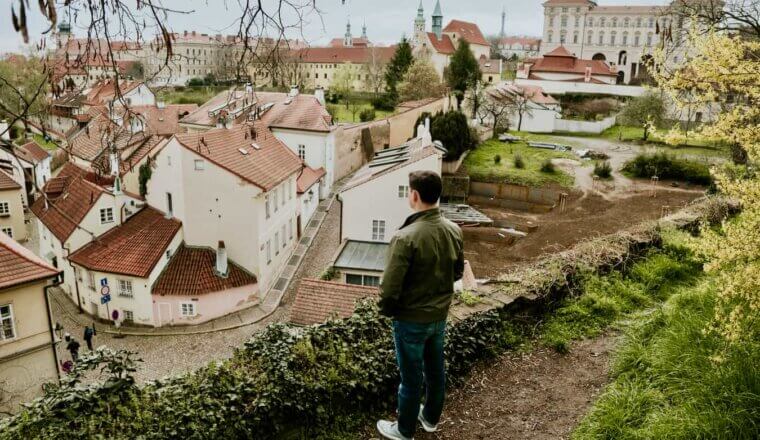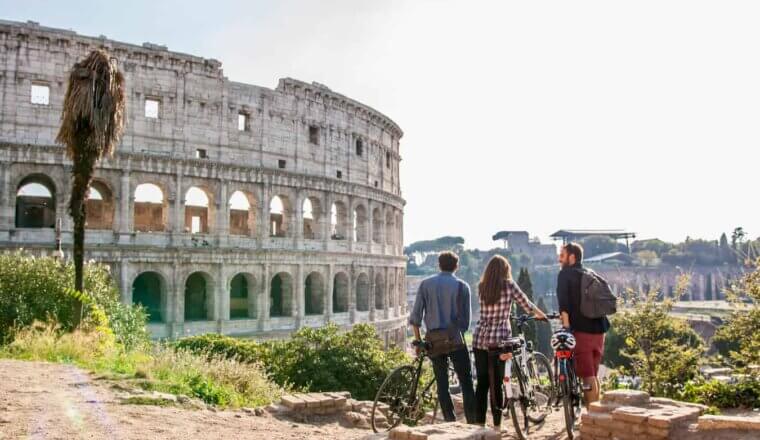Nestled in the center of Europe, The Czech Republic (also known by its short name Czechia) is a country steeped in history. It’s a land dotted with castles, medieval towns, beautiful mountains, ancient ruins, and world-class wineries.
Every year, more and more people visit this wondrous place but, sadly, they mostly stick to the capital, Prague, leaving the rest of the country unvisited.
However, once you escape that beautiful (but crowded) city, you’ll find an inexpensive country with some of the most striking and rugged landscapes in Europe. I love taking the train from place to place and just staring out the window at the rolling countryside.
This travel guide to Czechia will help you plan your trip, save money, and make the most of your time in this beautiful country!
Table of Contents
Click Here for City Guides
Top 5 Things to See and Do in Czechia
1. Explore Prague
Wind through the medieval streets, climb the hill to visit Prague Castle, gaze up at the Astronomical Clock, explore historical buildings and cobblestone streets, and enjoy the wild nightlife (or a more relaxed beer garden). With a rich history, there is so much to explore here. Stroll across Charles Bridge — one of the oldest standing medieval bridges in the world — or take a cruise along the Vltava River. You can admire historic architecture while exploring the iconic Old Town Square and catch world-class performances at one of the many theaters. No matter your interests, Prague won’t disappoint. It’s a city that lives up to all the hype. (Just avoid coming in July and August when the city is packed!).
2. See Ceský Krumlov
Situated on the Vltava River in the south of the country, this is a smaller, more picturesque version of Prague. Ceský Krumlov is home to fabulous museums, gorgeous churches, and plenty of historical sights. Explore Cesky Krumlov Castle, the country’s second-largest castle, and meander through the beautiful castle gardens. You can even visit the castle’s incredibly well-preserved Baroque-style theater and climb 162 steps to the top of the castle tower, which offers sweeping views of the city. The medieval architecture and red-roofed buildings make for beautiful pictures and a casual stroll through the streets is a great way to relax and enjoy the slower pace of life.
3. Drink up in the Moravian Wine Region
Although you might only think of beer when you head to the Czech Republic, the Moravian Region is actually famous for its wine. The Moravia region borders Austria and produces 90-95% of the Czech Republic’s wine. Picturesque villages are scattered throughout the area and in the town of Valtice, you can visit Chateau Valtice’s wine cellar, which has been around since 1430. Tours usually cost between 2,500-6,000 CZK.
4. Visit Kutná Hora
This historical town is home to the famous Sedlec Ossuary, aka the Bone Church. It’s a Roman Catholic chapel, built in the 13th century and adorned with over 40,000 human bones. There are bones hanging from the ceiling and an enormous candelabra made from skulls. There is also a display featuring skulls with wounds inflicted by various medieval weapons. Admission is 200 CZK. For more information (and photos), you can read about my visit.
5. Hike the Adršpach-Teplice Rocks
These natural sandstone cloisters are located in Bohemia, near the border with Poland. There are two clusters of formations: Adršpach Rock Town and Teplice Rock Town. There are numerous hiking trails that lead to unique rock formations, and the area remains a popular destination for rock climbers. In recent years it has become a popular site for the risky rock hopping sport (where people leap from rock to rock). You might be lucky enough to view a peregrine falcon soaring in the sky, as the area is one of their largest breeding grounds in Europe (they’re the fastest animal on the planet when in a dive). A train here from Prague costs around 300 CZK and takes about 5 hours.
Other Things to See and Do in Czechia
1. Try some pilsner in Pilsen
Pilsen is the birthplace of the Pilsner and the home of the original Pilsner Urquell Czech beer. A visit to the town makes a great day trip from Prague. During your visit, make sure to not only tour the Pilsner factory but also check out the beer spas where you can soak in a tub of beer (which, apparently, is good for you). Expect to pay around 1100 CZK for a soak. Don’t miss the 13th-century Gothic cathedral Saint Bartholomew and the botanical gardens while you’re here as well.
2. Tour Karlstein Castle
This castle is just a quick train ride from Prague. Founded in 1348 by Charles IV of the Holy Roman Empire, this Gothic castle safeguarded Bohemia’s crown jewels and holy relics. Due to warfare in the 15th century and fire damage in the 17th century, the castle underwent several reconstructions. The last reconstruction took place from 1887-1899, reviving the castle’s signature Gothic appearance. Attractions at the castle include an original 14th-century wall decoration and a replica of the royal crown of Bohemia. Admission with a tour is 240 CZK.
3. Adventure in Krkonoše
This beautiful mountain range — called the Giant Mountains — runs along the Czech-Polish border. It’s home to the highest peak in the country (Snežka Peak, 1,600 meters/5,250 feet). There are single-day and multi-day hiking trails as well as cycling paths if you come in the summer. The winter offers skiing for around 700 CZK for a lift pass.
4. Head to Telc
Telc, with its winding cobblestone streets, is one of the most picture-perfect examples of a Renaissance town in Europe. After a fire in 1530, the town was rebuilt. Medieval arcades with their gabled houses surround the picturesque town square and it’s just two hours south of Prague by car. The historic Renaissance and Baroque homes are a UNESCO World Heritage Site. Don’t miss the colorful stained glass in St. James Church as well as the historic underground tunnels, which you can tour for 30 CZK.
5. Visit Olomouc
Olomouc is a small university town noted for its parks, churches, sculptures, and fountains. Located just north of Brno, it’s also home to the Holy Trinity Column, a Baroque monument built between 1716-1754, and a grand astronomical clock — both of which are UNESCO World Heritage Sites. Outside the Olomouc Art Museum, see if you can spy “The Thief,” a sculpture erected in 2017 of a man dangling from the eaves of the building. Made from metal and fiberglass, the sculpture moves every hour and shouts down to passers-by on the street as he hangs from the edge!
6. Enjoy the Šumava National Park
Šumava is the country’s largest national park. It is a region full of densely forested hills along the border with Austria. Enjoy scenic lakes, trout streams, swaths of virgin forest, and important historic monuments. There is also tons of wildlife here, including lynx, owls, and elk. Admission to the park is free and camping is available.
7. Visit a nuclear bunker
Located 5 stories under Prague, this museum is full of Cold War paraphernalia. The bunker was designed to house civilians during a nuclear attack, after which they would then flee into the countryside. You’ll learn about life behind the Iron Curtain and get to explore the bunker yourself. There are gas masks, clothing, and newspapers from the period inside. It’s a neat snapshot of the past. Tours last two hours and cost 730 CZK.
8. Go rafting
Just 20 minutes from Prague is a white-water rafting course touted as the ultimate hangover blaster. Spend a day on the water battling the waves, followed by a barbecue lunch and a soak in a hot tub. There are Grade 2 and Grade 3 rapids, which take around two hours to navigate. Prices vary but expect to pay around 2,300 CZK per person.
9. Explore Macocha Gorge
Located near Brno, this sinkhole (also known as the Macocha Abyss) is an impressive 138 meters (452 feet) deep. It’s part of the Moravian Karst cave system and is a popular tourist site, suitable for both casual visitors who want to explore the sinkhole and those who have more advanced technical caving experience. The nearby Punkva caves can be explored from April-September, with admission costing 280 CZK.
10. Visit the Austerlitz Battlefield
The Battle of Austerlitz was one of the most decisive battles of the Napoleonic Wars (1803-1815) and is widely considered to be one of Napoleon’s greatest victories. It was here where he defeated the combined forces of Russia and the Holy Roman Empire, which led to the dissolution of the Holy Roman Empire. Over 16,000 people died in the battle, only 1,300 of which were from Napoleon’s army. Periodically there are re-enactments held here, perfect for fellow history buffs. There’s a large memorial as well as a small museum (admission is 125 CZK). If you want to hire a guide, expect to pay 3,000 CZK for a day trip. Currently, the memorial is closed until further notice due to construction.
11. Wander Bohemian Switzerland National Park
This national park is located in the northwest part of the country and is full of pine forests and deep valleys, majestic rock towers, and ravines. There are several nature trails leading into the surrounding gorges. For hiking, one of the most popular nature trails is the Gabriel Trail (6 kilometers/4 miles). You can reach the park in just over an hour from Prague by car.
12. Visit the Terezin Concentration Camp
Terezín was used during World War II as a Jewish ghetto and concentration camp. Although it was “only” a work camp and many Holocaust victims were then transported to extermination camps such as Auschwitz, 33,000 people died in the ghetto due to its abhorrent living conditions. Don’t miss a visit to the monument dedicated to the victims of the Holocaust. There is a museum in the ghetto area as well as a museum in the camp’s fortress. Self-guided visits are permitted and tickets start at 210 CZK. Expect to spend 4-6 hours seeing everything.
Czechia Travel Costs
Accommodation – Hostel dorms in the country cost around 300 CZK per night for an 8-10-bed dorm. Expect to pay double that for a bed in a 4-6-bed dorm. Free Wi-Fi is standard and most hostels have kitchens. It’s rare for hostels to include breakfast. For a private room, expect to pay at least 1,200 CZK per night.
Budget hotels start at 900 CZK per night for a basic double room with standard amenities (TV, AC, coffee/tea maker).
Airbnb is a budget-friendly option widely available around the country with private rooms starting at 375 CZK per night (though they average double that price or more). For an entire home or apartment, expect to pay at least 900 CZK per night. Again, prices are often double that (or more) so book early.
Camping is possible all around the Czech Republic. Wild camping is forbidden. Expect to pay at least 200 CZK per night for a basic tent plot with electricity at a campground.
Food – Czech cuisine is very hearty, heavily influenced by its neighbors Poland and Germany. When going to a local restaurant, expect a lot of soups/stews, sauerkraut, potatoes, breaded meats, and dumplings. One of the most famous dishes is goulash, a pork stew flavored with paprika and served with knedliky (bread dumplings).
For an inexpensive meal of traditional Czech cuisine, expect to pay at least 200 CZK. Fast food (think McDonald’s) costs closer to 174 CZK for a combo meal. Asian food such as Thai and Indian can be found in the larger cities and costs around 300 CZK for a main dish.
A three-course meal of traditional cuisine costs around 800 CZK, including a drink. Expect to pay around 50 CZK for a beer and 60 CZK for a latte/cappuccino.
If you are planning to cook your own food, a week’s worth of groceries costs around 500-800 CZK for basic staples like pasta, rice, seasonal produce, and some meat.
Backpacking Czechia Suggested Budgets
On a backpacker budget, expect to spend at least 900 CZK per day. On this budget, you will stay in a hostel dorm, take public transportation, need to limit your drinking, do free hikes, take free walking tours, and cook most of your own meals. If you plan to go out and drink more, expect to spend closer to 1,100 CZK per day.
On a mid-range budget, expect to spend at least 1,900 CZK per day. On this budget, you can stay in an Airbnb or private room at a hostel, take the occasional taxi or Uber to get around, do some larger activities like a wine tour or rafting, eat out for most meals and restaurants, and enjoy a few drinks.
On a “luxury” budget of around 3,500 CZK per day you can stay in a four-star hotel, do any activities you want, eat out anywhere you want, go out for drinks, and rent a car or take flights to get around. This is just the ground-floor for luxury though — the sky is the limit!
Czechia Travel Guide: Money-Saving Tips
Prices in Czechia have risen over the last few years but the country still remains affordable — especially when you get outside Prague. You’ll be hard-pressed to spend a ton of money if you stick to non-touristy areas, restaurants, and bars. That said, it’s always good to find ways to lower your costs! Here are some ways to save money when you visit the country:
- Buy tickets in advance – If you’re traveling through the country or the continent by train or bus, check online or head to the train station in advance to take advantage of the student discount prices. The sooner you book your tickets, the bigger discounts you’ll get.
- Get a City Pass – The Prague City Pass offers free admission to over 15 of the city’s main sights, including Prague Castle and the Palace. It costs 1,390 CZK per person and will save you money if you plan on seeing a lot. Brno also has a pass worth getting as well.
- Eat local – Belly up to the local bar for a plate of goulash and a pint and have a great meal. Traditional cuisine is the cheapest you’ll find.
- Bring your student ID – Many Czech cities, especially Prague, are student cities. Because of this, you’ll find tons of deals for those studying at a university. Show your student ID at museums and shops to save money.
- Take free walking tours – The country has plenty of free walking tours. These offer great introductions to the country and its history, so enjoy the stories and make sure to give your guide a tip at the end! Free Walking Tour Prague has the best tours in the capital. Just be sure to tip your guide at the end!
- Bring a reusable water bottle – The tap water here is safe to drink so bring a reusable water bottle so you can save money and lower your reliance on single-use plastic. LifeStraw makes a reusable bottle with a built-in filter so you can always ensure your water is clean and safe!
- Stay with a local – If you plan ahead, you can usually find a really nice Couchsurfing host for your visit. This way, you not only have a place to stay but you’ll have a local host that can tell you the best places to go and things to see.
- Explore the outdoors – There are plenty of free hiking trails all around the country for anyone looking to get outside. Czech Tourist’s Club, a hiking organization, produces maps for all the major routes in the country.
Where to Stay in Czechia
Czechia has tons of fun, social, and affordable hostels. Here are some of my favorite places to stay:
- PLUS Prague (Prague)
- MadHouse (Prague)
- Dream Hostel (Prague)
- Miss Sophie’s (Prague)
- Wake Up Wellness Hostel (Brno)
- Miss Sophie’s Olomouc (Olomouc)
- Cuba Bar and Hostel (Cesky Budejovice)
How to Get Around Czechia
Public transportation – In Prague, ticket fares are based on time and tickets range from 30 minutes (30 CZK), 90 minutes (40 CZK), 1 day pass (120 CZK) or 3-day pass (330 CZK). There are 4 lines which run from 4:45am until a little after midnight.
Prices are comparable in other cities around the country as well, usually costing around 30 CZK. In Brno, buses operate 24/7.
Bus – Traveling by bus is the most affordable way to get around the country. The journey from Prague to Brno is just 230 CZK for the 2.5-hour journey. From Prague to Karlovy Vary, the ride is 3 hours and costs 280 CZK. From Prague to Berlin, Germany the 4.5-hour bus ride starts at 490 CZK. Tickets sell out fast (especially in the summer) so book early if you can.
Train – Trains are more expensive than buses and don’t reach as many destinations in the country. However, they’re a lot quicker. Prague to Pilsen takes around 1 hour and 25 minutes and costs as little as 120 CZK. The 3.5-hour journey to Ostrava costs 230 CZK. The 6.5-hour trip from Prague to Budapest, Hungary is a lot pricier, with tickets starting at 900 CZK while the 6-hour ride to Nuremberg, Germany costs around 745 CZK.
To find routes and prices for trains around Europe, use Trainline.
Flying – Domestic flights are available but they are usually expensive compared to the train and bus — and not much faster. A round-trip flight from Prague to Brno takes around 1 hour and costs over 3,300 CZK. However, by the time you factor in getting to/from the airport, the bus or train is likely just as fast (and much cheaper).
Car rental – Car rentals can be found for as low as 450 CZK per day. To rent a car, you must be at least 21 years old and a surcharge might be added for drivers under the age of 25. For the best car rental prices, use Discover Cars.
Hitchhiking – Hitchhiking in the Czech Republic is safe and you can usually pick up a ride quickly. Note that hitchhiking is prohibited on major highways and motorways. Also, keep in mind that while many younger Czechs speak English, older folks generally speak only Czech. HitchWiki is the best website for additional hitchhiking info.
When to Go to Czechia
The Czech Republic has four distinct seasons. The summers are warm and dry while the winters are cold, snowy, and also pretty windy. Temperatures average around freezing in the winter (if not colder) so dress appropriately.
Unless you are planning on skiing or visiting the Christmas markets, the most popular time to visit Czechia is from May to September. This is also peak tourist season so expect crowds in Prague. The weather is very pleasant, however, with daily highs of 25°C (77°F). Try to avoid Prague in June-August if you can as the city gets packed.
During the shoulder season, you’ll avoid both the heat and the crowds. March-May and September-October are perfect for hiking and exploring as you’ll have cooler temperatures and get to see the leaves change. Expect temperatures around 14°C (59°F) and far fewer people in Prague.
How to Stay Safe in Czechia
The Czech Republic is a very safe country to visit, ranking in the top 25 safest countries in the world. Violent crime against tourists is virtually nonexistent.
That said, petty crimes like theft and pick-pocketing can occur, especially in high-traffic areas such as the city center in Prague. Keep your valuables out of reach when in public just to be safe. In smaller destinations and towns, it’s not really a problem.
There’s a few scams to worry about. If someone strikes up a conversation with you trying to sell something or if young children approach you, be on alert — their friend may be reaching for your wallet while you’re distracted. For more scams, read this post about common travel scams to avoid.
Solo female travelers should generally feel safe in the country, especially in smaller cities. The standard safety precautions apply (never leave your drink unattended at the bar, never walk home alone intoxicated, etc.). For specific safety tips, check out one of the many solo female travel blogs on the country.
If you experience an emergency, dial 150 for the fire department, 155 for an ambulance, and 158 for the police.
When in doubt, always trust your instincts. If a taxi driver seems shady, get out. If your hotel or accommodation is seedier than you thought, go somewhere else. Make copies of your personal documents, including your passport and ID, in case of an emergency.
The most important piece of advice I can offer is to purchase good travel insurance. Travel insurance will protect you against illness, injury, theft, and cancellations. It’s comprehensive protection in case anything goes wrong. I never go on a trip without it as I’ve had to use it many times in the past. You can use the widget below to find the policy right for you:
Czechia Travel Guide: The Best Booking Resources
These are my favorite companies to use when I travel. They consistently have the best deals, offer world-class customer service and great value, and overall, are better than their competitors. They are the companies I use the most and are always the starting point in my search for travel deals.
- Skyscanner – Skyscanner is my favorite flight search engine. They search small websites and budget airlines that larger search sites tend to miss. They are hands down the number one place to start.
- Hostelworld – This is the best hostel accommodation site out there with the largest inventory, best search interface, and widest availability.
- Booking.com – The best all around booking site that constantly provides the cheapest and lowest rates. They have the widest selection of budget accommodation. In all my tests, they’ve always had the cheapest rates out of all the booking websites.
- HostelPass – This new card gives you up to 20% off hostels throughout Europe. It’s a great way to save money. They’re constantly adding new hostels too. I’ve always wanted something like this and glad it finallt exists.
- Get Your Guide – Get Your Guide is a huge online marketplace for tours and excursions. They have tons of tour options available in cities all around the world, including everything from cooking classes, walking tours, street art lessons, and more!
- The Man in Seat 61 – This website is the ultimate guide to train travel anywhere in the world. They have the most comprehensive information on routes, times, prices, and train conditions. If you are planning a long train journey or some epic train trip, consult this site.
- Trainline – When you’re ready to book your train tickets, use this site. It streamlines the process of booking trains around Europe.
- Rome2Rio – This website allows you to see how to get from point A to point B the best and cheapest way possible. It will give you all the bus, train, plane, or boat routes that can get you there as well as how much they cost.
- FlixBus – Flixbus has routes between 20 European countries with prices starting as low 5 EUR! Their buses include WiFi, electrical outlets, a free checked bag.
- SafetyWing – Safety Wing offers convenient and affordable plans tailored to digital nomads and long-term travelers. They have cheap monthly plans, great customer service, and an easy-to-use claims process that makes it perfect for those on the road.
- LifeStraw – My go-to company for reusable water bottles with built-in filters so you can ensure your drinking water is always clean and safe.
- Unbound Merino – They make lightweight, durable, easy-to-clean travel clothing.
- Top Travel Credit Cards – Points are the best way to cut down travel expenses. Here’s my favorite point earning credit cards so you can get free travel!
- BlaBlaCar – BlaBlaCar is a ridesharing website that lets you share rides with vetted local drivers by pitching in for gas. You simply request a seat, they approve, and off you go! It’s a cheaper and more interesting way to travel than by bus or train!
Czechia Travel Guide: Related Articles
Want more info? Check out all the articles I’ve written on Europe travel and continue planning your trip:
